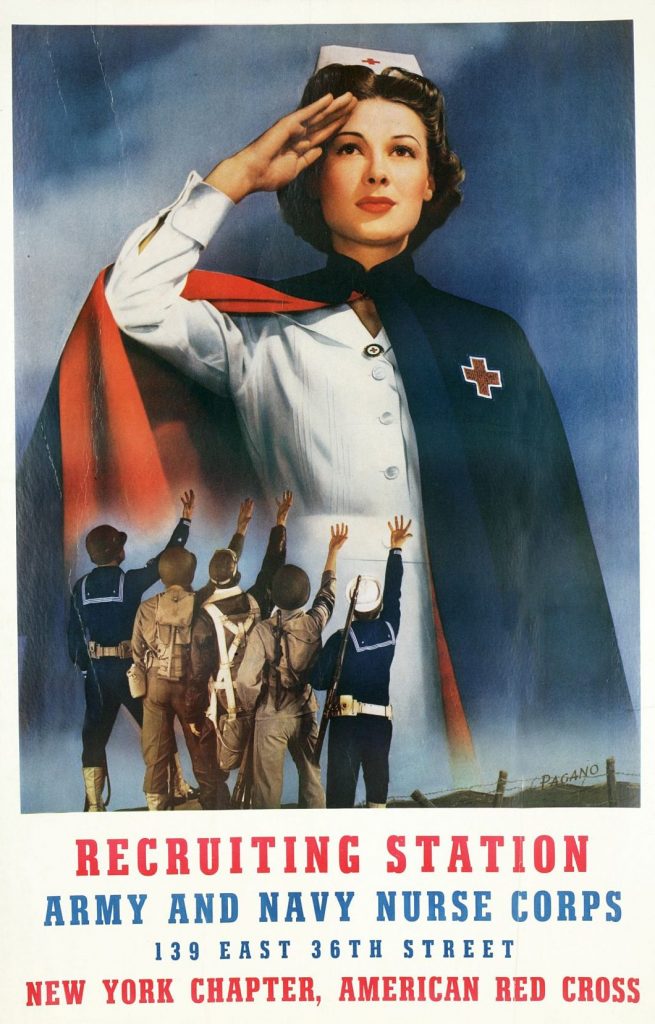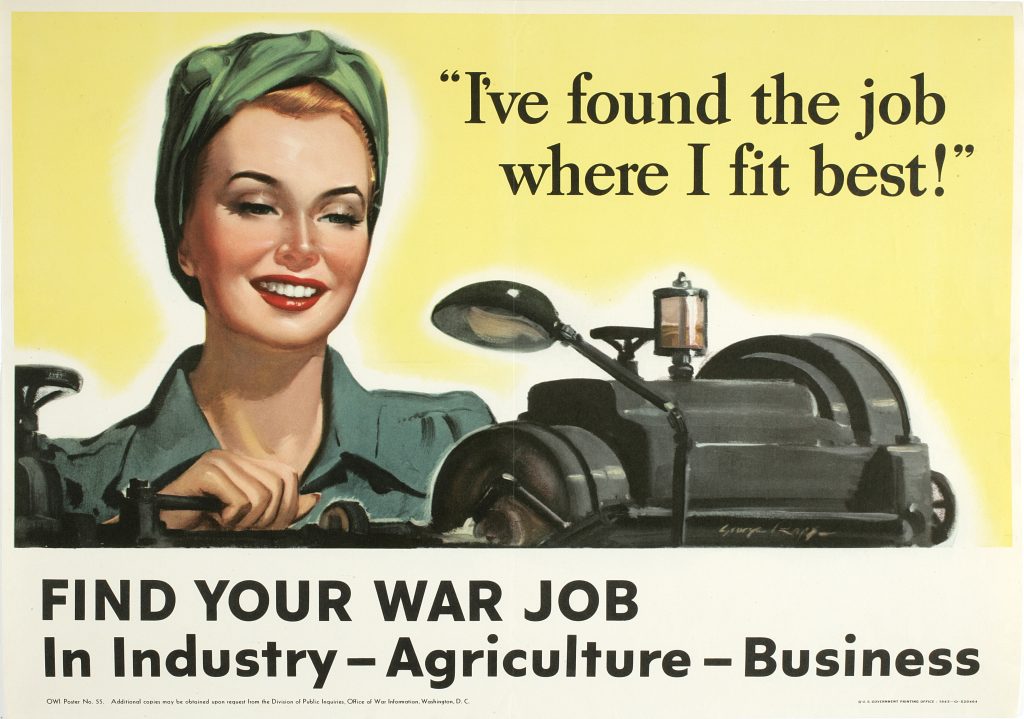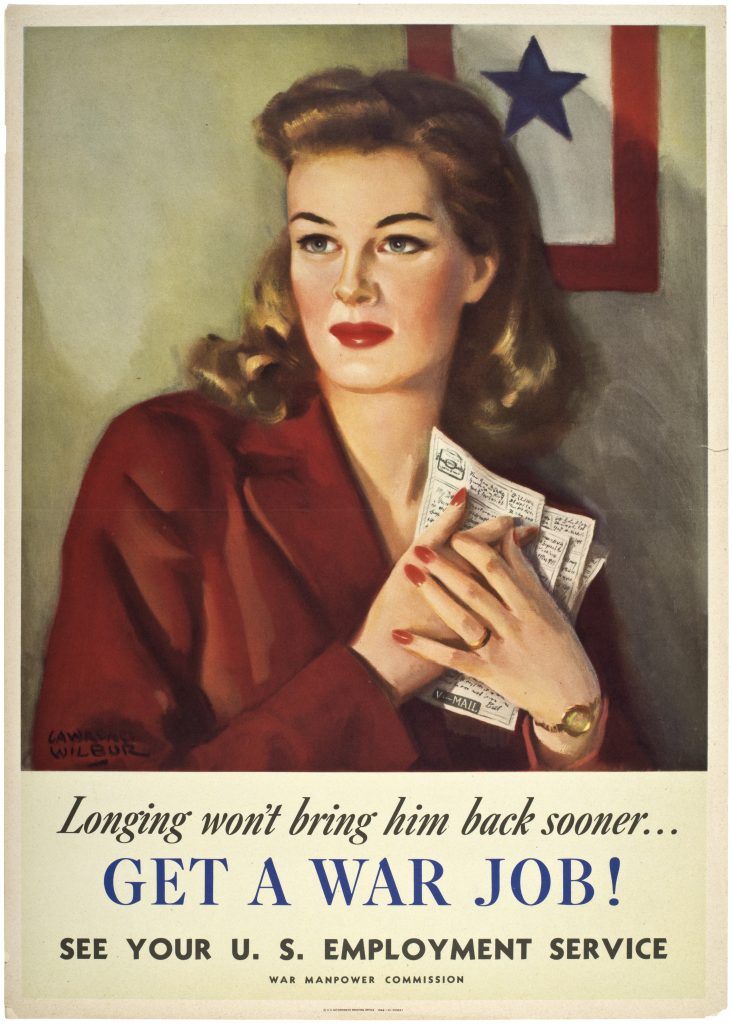Background
Within months of the Japanese attack on Pearl Harbor and America’s entry into World War II, propaganda posters encouraging women to leave the home appeared. This was a dramatic shift from the widespread belief during the Great Depression that the best way for women to help the nation was by staying at home and taking care of the family. While housework remained vitally important, the need for people to fill the massive number of jobs vacated by men who went to war opened the door for many women to work outside the home.
The government and its affiliates developed elaborate campaigns, often using posters, to get the word out to women. War work was a patriotic duty. All kinds of work—nursing, factory production, agriculture, administrative support, computing—contributed to the war effort in direct and indirect ways.
Over six million American women entered the workforce for the for the first time during the war. Before the war, the female workforce was predominantly young and single. This changed with the war. The average age of workers rose, and more married women than ever before worked outside the home. Patriotism and the desire to contribute to the fight for freedom in a meaningful way motivated many women to work. In addition, salaries for women increased during the war, providing much-needed financial relief. Women also valued the excitement of a new environment. Many women workers learned new skills, built new social networks, and found purpose outside of the home for the first time in their lives.
About the Image
Each of these posters was produced by a national organization or government agency seeking to recruit women to the war effort. All three embrace a stereotypical view of women as youthful, conventionally attractive, and white. While most war workers were indeed white, the complete lack of diversity hints at the challenges women of color faced breaking into war work.
The first poster was created by the Red Cross and encourages women to join the nursing corps.
The second poster encourages women to find a war job that suits their abilities or interests and mentions options in industry, agriculture, and business.
The third poster is like the second in that it promotes war work generally. Unlike the first and second posters that show a woman happily contributing to the war effort, this one shows a woman clutching a letter from a loved one who is fighting. The War Manpower Commission, which created this poster, accuses the woman of not doing enough to help.
Vocabulary
- agriculture: The practice of growing crops and raising animals in a farm setting.
- industry: Work related to producing goods in factories.
- stereotype: An oversimplified and often offensive assumption or description of a person or group of people.
- War Manpower Commission: A government agency that oversaw national labor needs in agriculture, industry, and the armed forces.
- Red Cross: An international organization formed in 1864 that provided—and continues to provide—nursing and other relief in emergency situations.
Discussion Questions
- What do these posters tell you about women’s roles during the war? How might this have been a major shift from the Great Depression years when women were expected to be in the home?
- What opportunities are available to women according to these posters?
- How does each poster speak to the possible motivations for women entering the workforce?
- How does each poster persuade the viewer to take action? What visuals and text are included to strengthen the message?
- How do the second and third posters speak to the extent to which women were involved in almost every aspect of war support?
- The second and third posters have a similar argument for women to find a job that works for them, but they take different approaches. How are these posters different? Do you find one more persuading than the other? Why or why not?
- What do the women across these posters have in common? What does this tell you about stereotypes related to women war workers?
Suggested Activities
- Lesson Plan: In this lesson designed for eleventh grade, students will learn about the experiences of women who entered the industrial workforce during World War II through a close analysis of propaganda.
- Compare these posters with the trio of World War I posters. To what extent did war propaganda change between the wars? To what extent did it remain the same? How did women’s roles change?
- Add the Homemakers’ War Guide poster to this collection and discuss how propaganda posters were used to influence women in and out of the home.
- Connect the first poster to the letter from a nurse at the front. How does each present a different view of what it meant to be a military nurse?
- Connect the second and third poster to the film about war work and the photographs of Black workers in the war work environment. How do these resources speak to one another and deepen students’ understanding of women and war work?
- Compare the poster “Longing Won’t Bring Him Back Sooner. . . ” to the engagement ring advertisement. How does each speak to the challenges men and women faced in maintaining romantic relationships in wartime?
Themes
WORK, LABOR, AND ECONOMY; POWER AND POLITICS









